Ideas are like the lifeblood of innovation, but they can also be the killer! A great idea with proper validation can be a rise for your business, whereas an idea with no proper validation can be the biggest mistake. As a result, it is critical to validate your ideas as soon as possible.
Now, we all know that in order to validate an idea, you must first generate one, which makes idea generation even more important.
But how exactly should you go through the process of idea generation? Moreover, how to validate them? Well, let’s find out.
In this blog, we are going to learn about idea generation and how to validate one, as well as everything you need to know about it.
Let’s go.
What is idea generation?
To keep it simple, idea generation is what the term suggests – a process of generating ideas. It is a creative process of unlocking the potential of your brain for brainstorming and coming up with innovative ideas.
Idea generation is a fun activity that usually takes place in a group. It is when the group members gather around with paper and pen in their hands, to jot down their ideas.
Each person brainstorms and presents their ideas to the group, which is then reviewed and feedback given. This allows the team to come up with even better ideas on which everyone can agree.
The importance and benefits of idea generation
Idea generation is an essential process for anyone who wants to create something new, solve problems, or improve existing systems. It’s the act of coming up with new ideas that can help your business in many ways. Here are some reasons why idea generation is important for any business:
1. Come up with innovative ideas
The process of idea generation is like playtime for your brain. When you push your brain to think of creative ideas it ends up generating some that no one would have thought otherwise.
Thinking outside the box allows you to grow out of the traditional way of thinking and generate excellent solutions to complex problems.
That is why, when you gather a group of people and include them in a brainstorming session, you end up generating a few innovative ideas.
This helps keep the wheels turning bringing fresh perspectives and opinions to the table, which often leads to the creation of better and more innovative ideas.
2. Helps you stay ahead of your competition
In today’s cutthroat environment, businesses must stay ahead of their competition.
When you constantly come up with innovative ideas, you differentiate yourself from your competitors and provide better value to your customers. This helps you stay on top of your industry and identify opportunities your competitors may have overlooked.
Whether it’s a new strategy, new product, new market, or anything else, idea generation will always help you stay ahead of your competitors.
3. Helps you save your time and resources
Idea generation often helps businesses save a lot of time and resources. That is because when you take part in an idea-generation process, you often end up with several excellent ideas to choose from.
Later on, you can evaluate each idea and dig down the most effective idea to persuade it and eliminate all the others. This helps businesses from wasting their time and money on ideas that will not work for them and shift their focus towards the right ones.
4. It boosts morale
Idea generation is a fun activity that brings group members together to brainstorm ideas in an energizing environment. This often creates a sense of collaboration and teamwork within the group.
By working together to generate ideas, the whole team creates a positive atmosphere that often encourages each member to take part in it.
This often boosts the morale of each team member helping them build even better relationships.
Idea generation process
The idea generation process is the process of creating, developing, and evaluating new ideas with a goal in mind. Here are the steps involved in an idea generation process:

Step 1. Identify a problem or opportunity
Problem or opportunity identification is the starting point of an idea generation process.
Here, the business first identifies a problem or an opportunity that it may have experienced or have come to know about through other means. This can also be done by observing your surroundings, brainstorming with others, or researching current trends and developments.
This is when the business realizes its need to find an idea for it.
Step 2. Research and gather information
Once you have identified a problem or an opportunity, your next job is to conduct proper research to gather information regarding the topic.
This can include reading articles, attending events, conducting surveys or interviews, studying case studies, or anything else that helps you know more about the topic.
Step 3. Brainstorm ideas
Now that you have identified your problem or opportunity and have gained enough information on it, it’s time to get the actual work done.
The team now gathers around to conduct a brainstorming session to come up with creative ideas for the topic. They may use several brainstorming techniques such as SWOT analysis, mind mapping, and brainwriting, to address the problem or opportunity.
Each team member must be given the chance to think outside of the box.
Step 4. Evaluate and select ideas
After you’ve finished brainstorming, collect all of your ideas and evaluate them to choose the best ones.
Under this step, each idea is evaluated based on its potential, feasibility, and its alignment with the goals you have set for the ideas. You can also consider what it will take to put each idea into action and select the ones that best suit your business.
Step 5. Refine and develop selected ideas
After you select a few ideas, you then need to refine and develop each one to make it better. You can do this by prototyping, testing, or iterating to determine what works best and what does not.
Step 6. Implement and monitor
Finally, implement and monitor the ideas you’ve selected for your goal to check their progress. Continuously evaluate its effectiveness, and make adjustments as necessary to ensure that it is achieving the desired results.
Idea generation techniques
Now let’s learn about some of the best idea generation techniques.
Usually, these are popular idea generation techniques used by businesses of all sizes to brainstorm and come up with creative ideas to achieve their goals.
Here are a few idea generation tools you can use:
1. Mind mapping
Mind mapping is a visual idea generation technique that helps you organize your thoughts and ideas to come up with creative solutions.
In this technique, you must begin by drawing a central topic that will serve as the foundation of your session. You’ll be creating branches that flow outwards from the central topic. These branches will be considered as the sub-topics.
You can repeat this process and draw as many branches as you like to generate creative ideas related to your main topic.
An example of this technique could be, writing “website traffic” as your main topic and creating branches such as “SEO”, “Promoting on Twitter”, and so on.
2. SWOT Analysis
SWOT Analysis is one of the most popular idea generation techniques used by many businesses to evaluate business ideas.
To begin, you create four columns on a blank page, with their headings, “strength”, “weakness”, “opportunity”, and “threat”.
Under strength, you will write about things your business is good at and has a competitive advantage in. Under weakness, you will list all of the areas in which your business lacks the capability. Under opportunity, you will list the opportunities your business has to improve its market position. Under threat, you can list all of the potential threats to your business.
This will give you ideas on areas where you need to improve, and areas where you can get an opportunity to grow.
3. Reverse brainstorming
Reverse brainstorming is an idea generation technique where the participant tries to come up with ideas in an unusual way.
For example, if the main goal of the session is to generate ideas to solve a problem, the participant begins by thinking about ways he can make the problem worse rather than solve it.
This allows him to approach the problem from a different angle. Furthermore, by considering ways he can worsen the situation, he comes to understand what he must avoid to solve it.
4. Brainwriting
Brainwriting is another excellent idea generation technique that lets each individual come up with their own creative ideas for a given topic.
To begin, the facilitator announces the topic that will serve as the foundation of the session. Following that, each participant is given a blank piece of paper and a pen and instructed to write down all of the ideas that come to mind for that topic. When completed, these ideas are shared with all members, and the best ones are chosen.
This technique eliminates the dominance of one voice over another and provides equal opportunity for each individual to share their ideas.
5. SCAMPER
SCAMPER is an idea generation technique that uses a series of questions to help you generate innovative ideas.
SCAMPER stands for Substitute, Combine, Adapt, Modify, Put to another use, Eliminate, and Rearrange.
- Substitute – What elements of a product or service could be substituted for something else?
- Combine – How different elements of the product or service can be combined to create something new?
- Adapt – How to adapt your product or service to a new environment?
- Modify – How you could modify it to make it better?
- Put to another use – How it can be used for different purposes?
- Eliminate – What elements of the product or service could be eliminated?
- Rearrange – How you could rearrange elements of the product or service to create something new?
By using this technique, you can come up with a wide range of innovative ideas for your products or service.
Now that we know everything about idea generation, it’s time to learn about idea validation.
What is idea validation?
Well, to explain it in simple words, idea validation is the process of testing out an idea to see if it is viable or not. It is just like an exercise where you ask yourself “would you rather questions”.
It is the process of finding out if an idea is worth pursuing or if it will only lead to a dead end. Idea validation is a fun way of challenging your own ideas to check their potential and how far you can go with them.
It can be as simple as asking your friends and families and getting feedback from them, or as complicated as conducting online surveys. Regardless of the process, idea validation is the process of testing your ideas to understand if it’s a fly or flop.
Importance and benefits of idea validation
Idea validation is crucial for ensuring every idea you select is worth pursuing for your business. It involves testing an idea to ensure that it is viable before investing serious money or resources into it.
Here are a few reasons why idea validation is extremely important for a business:
1. Saves time and money
Idea validation is like a crash test for your business. It’s a way of checking if an idea has the potential to achieve the results desired by the business.
Idea validation helps a business avoid the costly mistake of investing huge amounts of time and money in ideas that may not provide any results to them.
By validating the right idea at the right time, businesses can understand the actual potential of each idea and make decisions on how they should go about it.
2. Helps to identify the target market
Validating an idea involves gathering valuable feedback from potential customers to understand the pros and cons of your ideas.
This helps businesses identify their target market along with their needs and preferences, to develop their strategy in such a way that resonates with the target market.
3. Improves your chances of success
Idea validation is the process of testing and refining your ideas to ensure they are worth pursuing.
When you test your ideas you understand their pros and cons. This helps you move your focus on areas your idea lacks the potential and improve it to turn into an even better idea.
By doing this, you can fine-tune your idea and make sure it’s as strong as possible before bringing it to market. This can increase your chances of success and help you stand out from the competition.
4. Builds confidence and credibility
When you test your idea and it’s proven to be viable, you often feel more confident to execute the idea and go for it.
Furthermore, great ideas can help a business gain higher credibility in its industry as well. This is because when you share your ideas with the world, it often boosts your image as a successful business.
5. Building a customer-focused business
By conducting thorough research and validating the ideas, businesses get to learn about the needs and preferences of their potential customers. This helps them tailor their processes according to the likes of their customers to provide better value.
Idea validation process
Although there are numerous ways to validate your ideas, you can use these 4 most important steps for validating your ideas effectively. Here are the steps involved idea validation process:
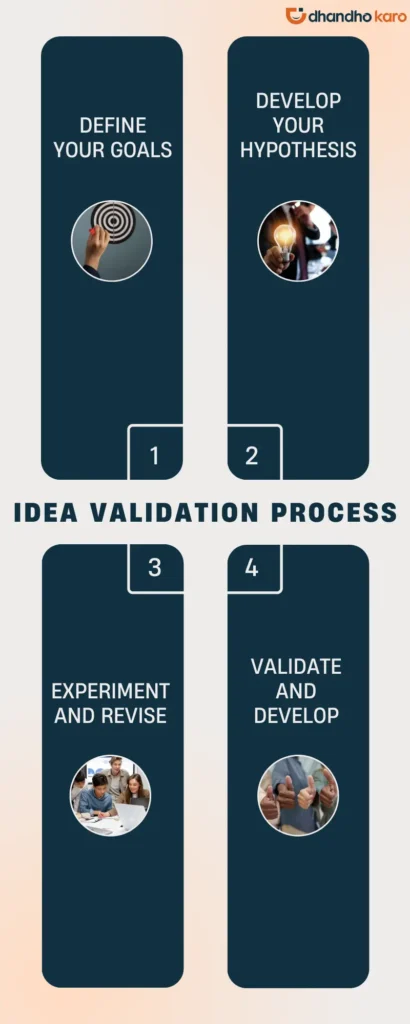
1. Define your goals
Your idea validation job starts with defining the goals you need to achieve with your idea. Whether it is to gain an advantage over an existing opportunity, solve a problem, or anything else. Here, you decide what you want to learn and what other aspects to validate.
A good strategy would be to list down every possible assumption for your idea and filter it down to the ones that are crucial for your business’s success.
2. Develop your hypothesis
Once you’ve defined your goal, your next job will be to develop your hypothesis. This will be the base around which you’ll be conducting your idea validation process to decide whether it’s a good one or not.
You can make your assumptions about the idea and how it can benefit your business, and use them for your idea validation process.
You would also want to determine the minimum test criteria to decide whether your idea is worth pursuing. An example of it could be setting a criterion such as “6 out of 10 people must agree with your idea”.
3. Experiment and revise
Now that you have defined your goal and developed a hypothesis, it is time to put your validation process into action.
You could put your ideas through various tests to see how viable they are. This experiment will answer your question about whether your idea is worth pursuing.
4. Validate and develop
At the final stage, you’ll have to decide whether or not your idea is viable. Your validation process will provide you with an overview of the actual potential of your idea and how you can proceed. And if your idea proves to be viable for your most critical assumptions, congratulations, you’ve got a great idea worth pursuing.
Best idea generation tools and idea validation tools
Now let us learn about some of the best idea generation and idea validation tools.
1. MindMeister

MindMeister is a cool idea generation tool that can assist you in coming up with brilliant business ideas.
It is a free online mind-mapping tool that allows you to brainstorm and organize ideas for your topic. This tool will assist you in developing a central concept and then branching it out into subtopics and related ideas, resulting in a web of interconnected thoughts.
MindMeister can be used not only for idea generation but also as a business idea validation tool. The mindmaps you create on the platform can be shared with others to get feedback and opinions on how to improve your ideas.
2. Mentimeter
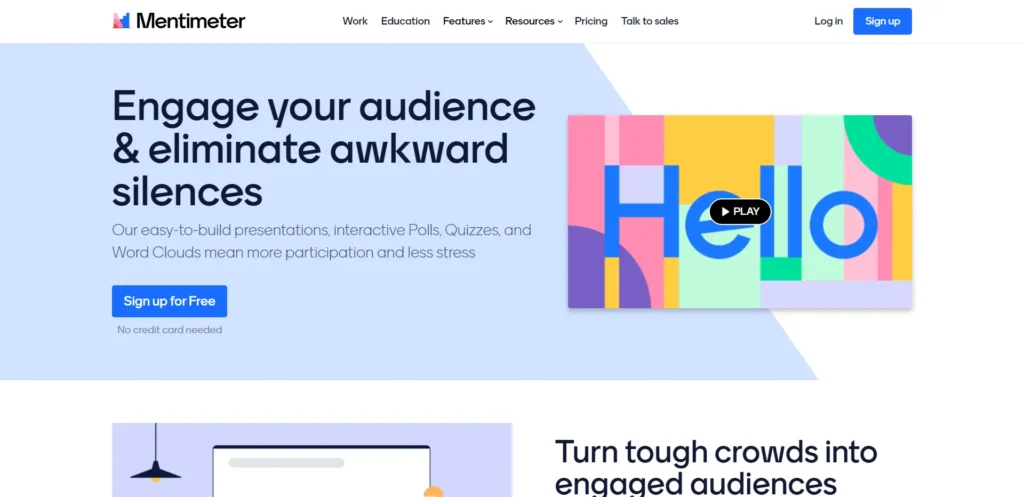
Are you looking for an idea generation tool? Well, Mentimeter is the right tool for you.
Mentimeter is a versatile idea generation and validation tool that can be used for brainstorming, engaging audiences, and gathering feedback.
The platform enables teams to create and share presentations and polls with a live audience, as well as collect feedback to evaluate and generate new ideas. MindMeister is the ideal tool for your business, whether you are conducting a brainstorming session, market research, or validating your ideas.
3. Survey Monkey
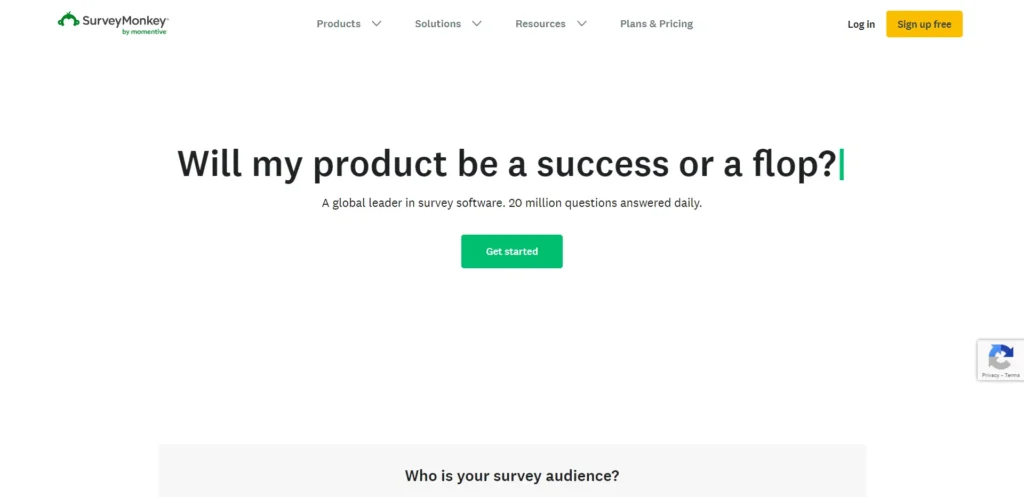
If you’re looking for a tool that’s just right for validating ideas, Survey Monkey might be the one for you.
Survey Monkey is an online idea validation tool that enables businesses to quickly and easily create surveys and collect feedback from their target audience. Businesses can validate their ideas by simply asking specific questions about them their target audience. Furthermore, the tool provides a report on your target audience’s needs and preferences to help you generate better ideas.
4. Aha!
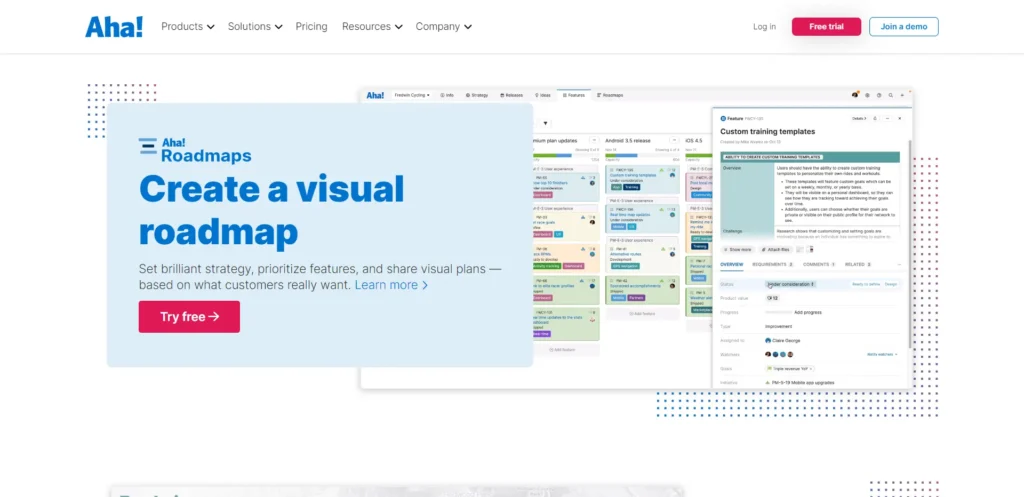
Aha! Is an all-in-one idea generation tool that millions of businesses rely on to develop and implement business strategies.
This online platform includes tools for idea generation and brainstorming, as well as evaluating and validating them.
Aha! enables teams to collect and collaborate on ideas, feedback, and suggestions from various sources in real-time. It offers customizable templates, roadmaps, and reports to assist businesses in communicating their product vision to stakeholders and tracking progress.
At long last, Aha! Is an excellent idea generation platform for businesses looking to streamline their product development process.
5. User Testing
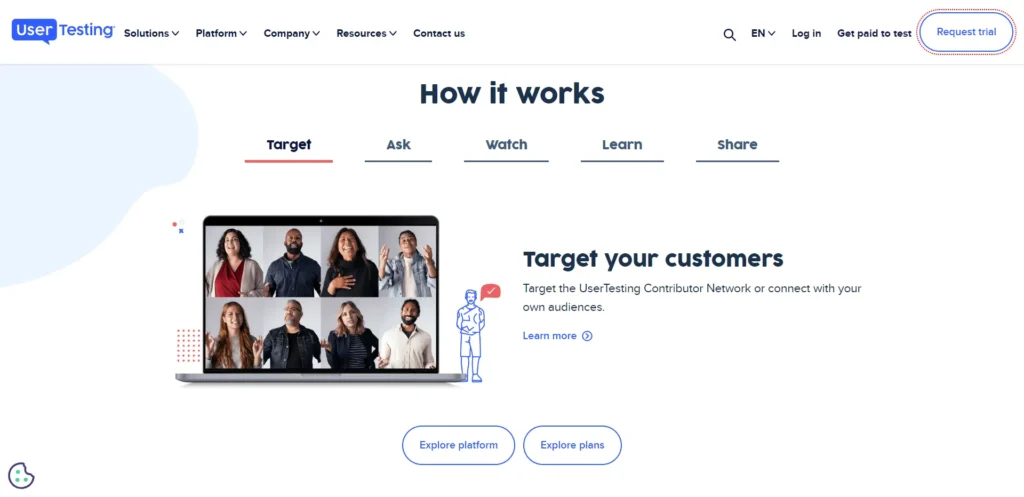
UserTesting is another idea validation software that helps businesses get feedback from real users to improve their products and services.
Businesses can use UserTesting to conduct usability tests, remote interviews, and online surveys to evaluate and validate their ideas. It also provides detailed information on user needs and preferences, as well as their behavior, allowing you to tailor your ideas and create one that your audience wants.
6. Qmarkets

Qmarkets is an idea generation and idea validation platform that provides a range of tools for idea generation and idea validation in organizations.
The platform includes tools for brainstorming, ideation campaigns, and a collaborative space for users to share and develop their ideas.
It is aimed to make it easier for staff, customers, and partners to find projects, crowdsource ideas, and manage new ideas.
7. Xmind

Xmind is another brilliant mind-mapping tool for visually organizing your thoughts and ideas.
You can use the idea generation tool to create flowcharts, mind maps, diagrams, and other visual representations of your ideas. The simple interface allows you to quickly create nodes and sub-nodes, as well as add text, images, links, and attachments. You can also create mind maps with different structures to help you organize your ideas much better.
8. Coggle

It can be difficult to compile and store your ideas and you will no doubt require a simple means of organisation. You can make and share mind maps and flowcharts online using Coggle.
It enables you to develop plans, take notes, brainstorm, and illustrate your ideas. You can add loops, join branches, floating text, and photos to your chart to enhance its quality.
Additionally, you can invite your creative partners and coworkers to collaborate with you simultaneously on the same chart for more efficient idea generation.
9. Idea Drop
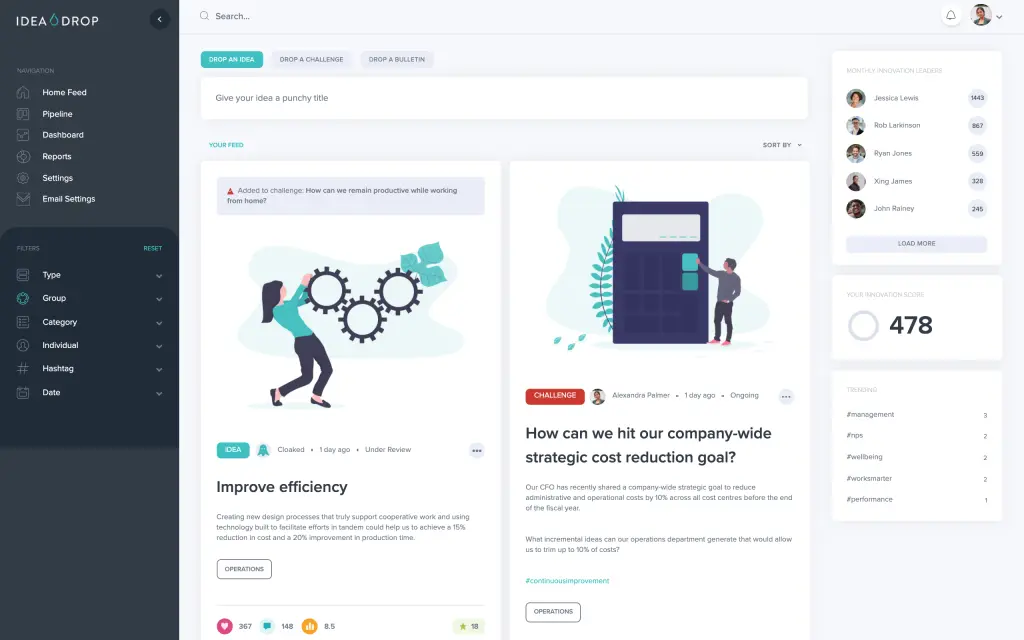
Idea Drop is a cloud-based software that helps teams effectively create and validate ideas.
The platform’s simple functionality facilitates the collaborative process of brainstorming, ideation, and innovation. Additionally, Idea Drop includes features that aid in the ideation process, such as upvoting and downvoting, commenting, and tagging, allowing users to collaborate and evaluate each other’s ideas.
10. Exago

Exago is idea management software that helps businesses collect, evaluate, and implement ideas from their employees, customers, and partners.
The platform brings together all of the individuals with their collective experience to solve the most critical business problems, both within and outside of its operations.
It is a cloud-based platform designed to help businesses of all sizes in innovating, increase productivity, and increase profits.
FAQs related to idea generation & validation
-
How can I get started with idea generation?
To get started with idea generation, you need to first determine the base for it. In other words, you’ll have to identify a problem or opportunity that you want to address.
-
How can organizations encourage idea generation and innovation?
Organizations can encourage idea generation and innovation in many ways, such as, promoting a risk-taking culture, creating an environment that encourages creativity, providing resources for idea development, and so on.
-
What are some common mistakes to avoid when validating an idea?
The biggest mistake you must avoid when validating an idea is relying too heavily on personal opinions or assumptions. You must always validate your ideas based on opinions from potential customers, and must always be open to feedback.
Conclusion
Innovative ideas are important for every business regardless of the industry. However, it can be difficult when you don’t know where to start.
That’s when idea generation and validation come in handy. With the right tools and techniques, you can easily generate the most effective ideas and validate them to shape them into ones perfect for your business.
Just remember to keep an open mind, be open to feedback, and accept failure as an important part of the innovation process.


